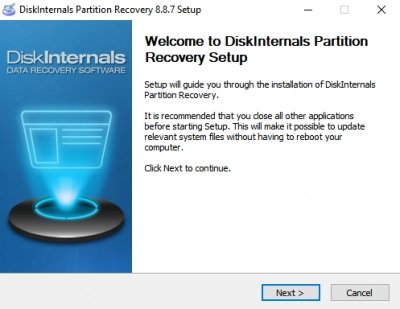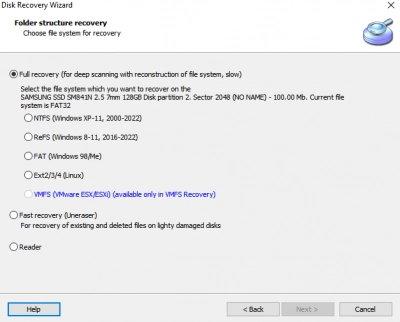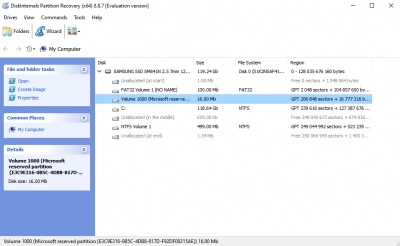How to Fix the “Critical Structure Corruption” Error on Windows 10

Here you will find out:
- what “CRITICAL_STRUCTURE_CORRUPTION” error is
- how to fix this issue
- how DiskInternals Partition Recovery can help you
Are you ready? Let's read!
What is “CRITICAL_STRUCTURE_CORRUPTION” error?
Windows 10 users have noted instances of the Critical Structure Corruption error, a type of Blue Screen of Death (BSOD) issue. Common triggers for this error range from hardware malfunctions and system instability to problematic drivers. Other potential causes include corrupted system files, unreliable hard drives, or abrupt system shutdowns. Luckily, various strategies exist to fix the Critical Structure Corruption error in Windows.
What causes the “CRITICAL_STRUCTURE_CORRUPTION” error?
There is no one definitive cause for the complex Windows 10 issue known as "CRITICAL_STRUCTURE_CORRUPTION." However, based on feedback from the active user base of the operating system, it has been tied to two scenarios:
1. A hardware component, such as a faulty memory card or motherboard, has become corrupted, causing the computer to malfunction and the error to appear.
2. A driver has made changes to critical kernel code or data, either intentionally or accidentally, resulting in the unexpected error.
Fortunately, there are multiple ways to solve this problem. To protect your files and system from the blue screen of death, follow the steps below, which have been proven to work against the "CRITICAL_STRUCTURE_CORRUPTION" error.
12 Ways to Fix the Critical Structure Corruption BSOD in Windows 10
1. Boot your Windows Into Safe Mode
Safe mode is a built-in utility in Windows that disables unnecessary drivers and programs, which may cause issues for the system. If you suspect that a driver or program is causing your PC to crash, booting it into safe mode is an effective way to test your suspicions. When your PC crashes while booting normally but stays stable in safe mode, it's likely a software or driver issue. To learn how to boot your PC into safe mode, refer to our comprehensive guide on booting Windows 10 into safe mode. Once you've done that, you can troubleshoot the Critical Structure Corruption BSOD by focusing on the issue without any unnecessary programs running in the background.
2. Carry Out a Clean Boot
Performing a clean boot on your PC involves booting it with the minimum set of drivers and software, disabling any unnecessary startup programs that could be causing issues for Windows. This method allows you to isolate the programs that might be responsible for the Critical Structure Corruption BSOD.
To perform a clean boot, follow these steps:
1. In the Start menu search bar, type "sysconfig" and select the Best match.
2. In the Services tab, select the Hide all Microsoft services checkbox and click Disable all.
3. Switch to the Startup tab and select Open Task Manager.
4. Disable each startup app listed under the Startup tab in Task Manager.
5. Close the Task Manager and click on OK under the System Configuration tab.
When you restart your PC, it will boot up in a clean boot environment. If you're still experiencing issues, then the problem may be caused by something else and you should try the next method. However, if the clean boot resolves the problem, then you'll need to enable each app one by one to identify the culprit responsible for the Critical Structure Corruption in your copy of Windows 10. After enabling each app, restart your PC and check if the problem reappears.
While it can be a bit time-consuming, performing a clean boot has been known to fix many Windows problems, making it a worthwhile effort.
3. Run BSOD Troubleshooter
To resolve the Critical Structure Corruption error on Windows 10, you can use the BSOD Troubleshooter, which is a built-in troubleshooting tool. Follow these steps to run the troubleshooter:
1. Open Settings and navigate to Update & Security.
2. Click on Troubleshoot from the left-hand menu.
3. Under Find and fix other problems, select BSOD error and click on Run the troubleshooter.
4. Follow the instructions provided to troubleshoot and fix the error. Once done, restart your computer.
4. RUN SFC/Scannow
If you're experiencing Critical Structure Corruption in Windows 10 due to corrupt system files, you can use the System File Checker (SFC) tool to scan for and repair them. Follow the steps below to use this built-in troubleshooting tool:
1. In the Windows Search box, type "cmd" to open Command Prompt.
2. Right-click on Command Prompt and select "Run as administrator".
3. In the Command Prompt window, type "sfc /scannow" and press Enter.
4. Wait for the scanning process to complete.
5. Once the process is finished, close the Command Prompt window and restart your system.
5. Check Your Hardware
Driver issues can often be the cause of BSOD errors, particularly if your machine has been in use for an extended period of time. To scan for problems with the help of the Memory Diagnostic Tool, follow these steps:
Memory Diagnostics is another in-built Windows utility that works by inspecting your PC's RAM, motherboard, and other hardware components for issues. In most cases, the tool will alert you automatically if the problem is severe, but you can also run the tool manually to check that it hasn't missed anything that has gone wrong.
To run Memory Diagnostics:
1. Press Win + R to open the Run dialog box, type mdsched.exe, and hit Enter.
2. Select Restart now and check for problems to immediately inspect problems on your computer.
After your computer restarts, the Memory Diagnostics Tool will run a complete check on your PC. If you don't encounter any issues here, you can be confident that your hardware is fine and the root cause of the error lies elsewhere.
6. Check the Event Viewer
If you're unsure about the cause of the "Blue Screen of Death" error, the Event Viewer can help identify the issue. This built-in tool allows you to see the last event that occurred before the crash, which can help you remove the app or disable the service responsible for the issue.
To access the Event Viewer:
1. Press the Windows + X keys on your keyboard and select "Event Viewer" from the context menu.
2. Click on "Windows Logs" in the left panel and select "System" to view all events with timestamps.
3. Look for the last event recorded before the "CRITICAL_STRUCTURE_CORRUPTION" error occurred. If you see a specific application or service, it's likely the culprit.
7. Update your graphics driver
It's crucial to keep your drivers up to date as outdated graphics drivers can cause frustrating errors on your device, potentially leading to blue screens. Fortunately, updating these drivers is a simple process that doesn't require any expertise. Just follow our steps to ensure that you have the latest version of your driver.
8. Update Windows 10 to the latest release
If none of the previous methods prove successful, upgrading to the latest Windows 10 release is the final option. This update can address bugs, provide new features, and fix security vulnerabilities, among other things.
Here are the steps to update Windows 10:
1. Click on the Start menu and select "Settings," or use the Windows + I keyboard shortcut.
2. Choose the "Update & security" tile.
3. Ensure that you are on the "Windows Update" tab.
4. Click on "Check for updates."
5. When an update is found, select "Install" and wait for Windows 10 to download and apply the update.
9. Uninstall potential problematic software
It's important to note that some third-party programs that functioned smoothly on Windows 7 may not operate well on Windows 10. Using these incompatible programs can result in a critical structure corruption stop code on Windows.
However, it may be difficult to determine which software is causing the issue. To address this problem, we recommend uninstalling the following programs:
- Antivirus software
- Virtual Drive software
- Automatic Driver Updaters
- GPU and CPU overclocking applications
- Intel built-in applications for system management.
10. Use DiskInternals Partition Recovery
At some point, after you have tried all the methods explained above and none worked for you, the best reliable option is to use a third-party data recovery solution like the DiskInternals Partition Recovery app. This data recovery solution works on all Windows OS computers and features an intuitive interface – integrating a Wizard interface – that makes it easy for virtually any computer literate to use the software.
DiskInternals Partition Recovery can recover files and folders from any storage device, drive, disk, or media. It comes with three recovery modes, so you can easily choose the one that is best for you. Also, this software is more advanced than the DiskInternals Uneraser software, which also works good for system-wide data recovery on any disk. Furthermore, the Partition Recovery software can read any of the known file system formats for Windows, macOS, and Linus OSes.
With DiskInternals Partition Recovery, you can recover lost folders and files, regardless of how they were deleted from the computer. More so, you won’t have to pay for the PRO version until you confirm that your lost files have been recovered. There’s a built-in File Preview engine that lets you preview the recovered files for confirmation before upgrading your software to get them saved on your PC or remote storage. Here’s a guide to using DiskInternals Partition Recovery.

- Step One: Install the Partition Recovery software on your computer system and launch it to recover your lost files. If the folder was lost from an external drive, connect the drive to the computer where the DiskInternals software is installed.

- Step Two: Select the drive where the lost LOST.DIR file was previously located and choose a data recovery mode: Fast Recovery or Full Recovery.

- Third Step: Full recovery takes more time but recovers deeply because it goes deeper into the drive to find lost files. When the scanning is complete, you’d see the deleted files appear with a red asterisk to indicate they are the files you need to recover.

- Fourth Step: Preview the recovered files to confirm they are the ones you want to get back. Simply select the file(s) and click on the “Preview” option.
- Fifth Step: The recovered files must be saved to a new storage location and not the same drive where they got lost from. Interestingly, you can export the files to remote storage via FTP.
Note: DiskInternals Partition Recovery uses an advanced recovery algorithm trusted by IT experts for more than 15 years.
11. Reinstall Windows
If the previously mentioned solutions do not resolve the issue of Critical Structure Corruption in Windows 10, the only remaining solution is to reinstall Windows. To accomplish this, use the Windows media creation tool to reinstall your Windows and address this problem.
Note that reinstalling Windows will result in the complete erasure of system data. However, you can recover your data using professional Windows Data Recovery Software.
Rescue Lost Files Due to BSOD (Critical Structure Corruption)
In the event that you lose important data while attempting to address the Critical Structure Corruption BSOD error, a robust data recovery tool like Partition Recovery can assist with data retrieval. This user-friendly software can recover data from formatted, corrupted, non-bootable, or completely crashed systems. It can recover a variety of data types, such as files, folders, documents, photos, videos, audio, and more.
FAQ
What causes critical structure corruption?
Critical Structure Corruption is a Blue Screen of Death (BSOD) error that occurs in Windows 10 when a critical component of the operating system's kernel encounters a problem that it cannot resolve. The issue can arise due to various reasons, including faulty hardware, outdated or incompatible device drivers, software conflicts, corrupted system files, overclocking, and malware infections. Additionally, power supply problems, hardware failures, and overheating can also lead to this error. It is crucial to identify the underlying cause of the problem to resolve the issue effectively.
What does the blue screen of death mean?
The Blue Screen of Death (BSOD) is an error screen that appears when the Windows operating system encounters a critical error that it cannot recover from. When this happens, the system crashes, and the blue screen is displayed with a stop error code and a message describing the cause of the error.
The BSOD can occur due to a variety of reasons, including hardware failures, driver issues, software conflicts, corrupted system files, and malware infections. It is a safety measure implemented by the Windows operating system to protect against further damage by shutting down the system to prevent any data loss or hardware damage.
The Blue Screen of Death is a serious error and can lead to the loss of unsaved data or even permanent data loss. It is important to take note of the stop error code and message displayed on the screen to identify the cause of the error and find a solution to fix it.
Does System Restore fix blue screen?
System Restore can potentially fix a blue screen error if the issue is caused by a recent software installation, update, or configuration change. System Restore allows you to roll back your system to a previous state, which can be helpful if a recent change is causing the blue screen error. To use System Restore, follow these steps:
- Press the Windows key + R on your keyboard to open the Run dialog box.
- Type "rstrui" into the Run dialog box and press Enter to open System Restore.
- Select a restore point that was created before the blue screen error started occurring.
- Follow the prompts to complete the System Restore process.
However, System Restore is not guaranteed to fix blue screen errors, especially if the issue is hardware-related or caused by a malware infection. In such cases, it is recommended to seek professional help or try other troubleshooting methods such as updating drivers, performing a virus scan, or reinstalling Windows.
